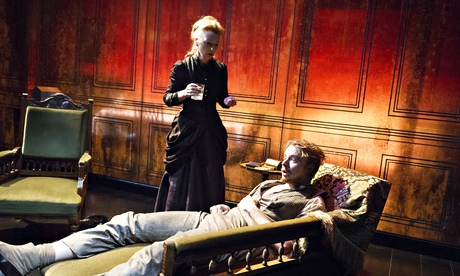
I recall a Punch cartoon of the late 1950s showing two moviegoers gazing in astonishment at the latest 3D spectacle. "Next thing," one of them remarked, "they'll be having real people up there." But we are now in an era when the gap between film and theatre, thanks to sophisticated technology, is constantly narrowing. I went this week to a preview of Digital Theatre's screen version of Richard Eyre's Almeida production of Ibsen's Ghosts: I can only say that it offered an experience comparable to that I had in the theatre. I'd also recommend everyone to see it when it's shown in 200 cinemas across the UK and Ireland on 26 June.
It's not quite the same as National Theatre Live, where cinemagoers vicariously attend a single performance. Digital's Ghosts, I'm told, was shot over three successive evenings during the show's run at the Trafalgar Studios. But, whatever the process, the result is to democratise theatre. It's not just that the performance can be seen worldwide. The key point is that everyone now has the best seat in the house.
Sitting in the fifth row at the Almeida, I was able to catch every nuance of Lesley Manville's brilliant performance as Helene Alving. One moment I particularly treasured was the slight narrowing of her eyes as she decided to make a move on Pastor Manders with whom she had once been despairingly in love: in the cinema we can all share that moment just as we can detect the flicker of panic in the features of Adam Kotz's Manders as she draws his hand to her breast.
It also strikes me that Ghosts is especially well suited to the close up technique adopted here. It's an intimate, claustrophobic, five character play that, especially in Eyre's interval-free version, locks you into its chosen world: it's like watching a Greek tragedy taking place in 19th-century Norway.
Peter Mumford's expressive lighting gives you a hint of the outside world, especially when the screen reddens to indicate the fire at the orphanage dedicated to Mrs Alving's debauched husband. But the main point is that Ibsen's intensity suits the cinema; and the camera gives one a close up, in the shattering final moments, of the distorted face of Jack Lowden's syphilitic Oswald, which not even the most privileged theatrical spectator could have.
The film, of course, wouldn't exist without Eyre's original production; and you inevitably lose the permanent wide angled vision of designer Tim Hatley's transparent-walled set which you get in the playhouse. But, while I remain an evangelist for live theatre, I think it's time we stopped pretending that it offers an unreproducible event. A theatre performance can now be disseminated worldwide with astonishing fidelity. This represents, as I noted when I saw the first ever National Theatre Live transmission of Racine's Phèdre, a revolution which knocks on the head the old argument that theatre is an elitist medium aimed at the privileged few.
• Watch a clip from the Olivier-winning Ghosts starring Lesley Manville
• Ghosts reviewed by Michael Billington

